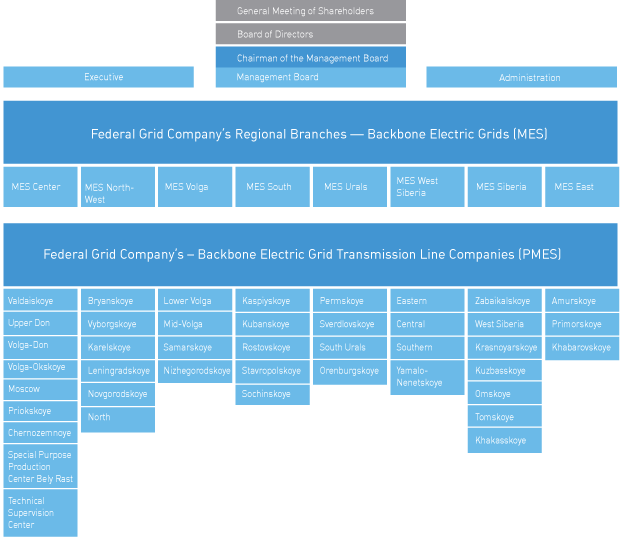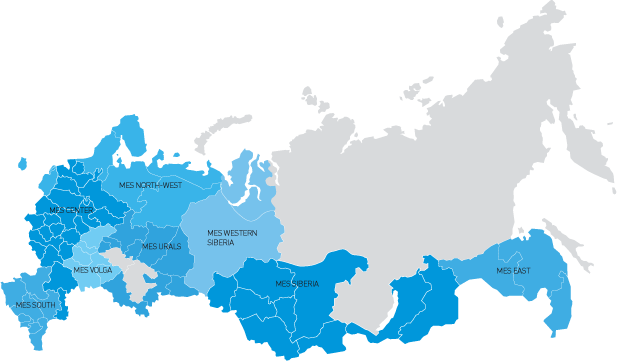Key Company Data
The Unified National (all-Russian) Electric Grid (UNEG) is a complex of electric power grids and other electric grid facilities, providing for the reliable supply of power to consumers, for the functioning of the wholesale electricity and capacity market and for the parallel operation of Russian and foreign energy systems. The rated voltage class, the throughput capacity and energy flow reversibility, as well as other process characteristics of the power grid facilities integrated into the UNEG, are subject to approval by the Russian Government.
Federal Grid Company was established in 2002, in accordance with Russia’s power sector reform package. The Company’s operational priority lies in transmitting electric power via backbone grids. The Company is a natural monopoly in this sphere. The Company is also included in the list of strategic organizations.
The Company has a unique infrastructure that forms the physical backbone of Russia’s domestic economy:
- Large scale: power grid facilities are located in 75 Russian regions, with an area totaling 14.8 million square kilometers. Half of Russia’s total energy consumption is provided for using energy transmitted across the Company grids;
- Stable financial condition: the largest share of the Company’s receipts is generated via tariffs for energy transmission, as approved by the Federal Tariff Service (FTS), using the RAB-regulation method. /li>
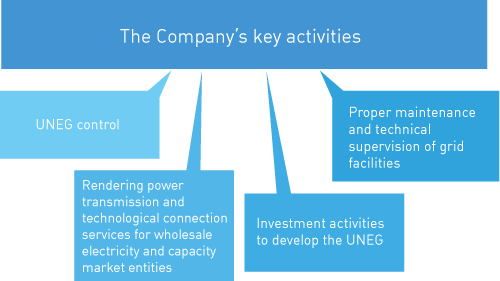
| Key Performance Indicators | 2008 | 2009 | 2010 | 2011 | 2012 |
|---|---|---|---|---|---|
| Number of substations.* | 800 | 804 | 805 | 854 | 891 |
| Length of power transmission lines, total, thousand km** | 121,5 | 121,1 | 121,7 | 124,6 | 131,6 |
| Electric energy supplied to the grids of the distribution grid companies, to direct consumers and to the independent JSC-Energo, net (kWh, billion) | 471 958,118 | 452 662,172 | 470 648,072 | 484 663,552 | 498 287,684 |
| Electric energy supplied via UNEG grids to bordering states, net (kWh, billion) | 16 704,763 | 13 628,309 | 15 716,33 | 19 284,808 | 15 768,826 |
| Customer contract demand (MW) | 90 042 | 94 636 | 91 179 | 90 937 | 90 492 |
| Electric energy losses in the UNEG grids (kWh, million) | 21 866 | 22 121 | 22 526 | 22 553 | 21 946 |
** Including leased transmission lines
*** According to the WECM data.
| Key Financial Indicators (RUR million) | 2008 | 2009 | 2010 | 2011 | 2012 |
|---|---|---|---|---|---|
| Revenue (net) from the sales of goods, products, and services | 68 485 | 85 078 | 111 085 | 138 137 | 138 836 |
| Adjusted EBITDA* | 32 718 | 40 379 | 67 405 | 84 683 | 82 847 |
| Profit (loss) before tax | 6 177 | - 54 049 | 67 312 | 11 444 | 14 232 |
| Net (retained) profit (loss) | 4 465 | - 59 866 | 57 082 | -2 468 | -24 502 |
| Adjusted net profit* | 7 772 | 9 427 | 25 702 | 33 687 | 13 413 |
| Net asset value | 666 471 | 579 746 | 794 470 | 853 801 | 849 877 |
| Market capitalization | 141 882 | 367 971 | 452 717 | 351 138 | 253 905 |
The Company’s Organizational Structure
The Company’s supreme governing body is the General Shareholders Meeting. The Board of Directors determines the Company’s development strategy and controls the activities of the Management Board. The Management Board controls the Company’s operations.
As of 31 December 2012, the Company incorporates 51 regional branches, including:
- 8 backbone electric grids (MES)
- 41 backbone electric grid transmission line companies (PMES)
- 1 dedicated production base “Bely Rast”
- 1 Technical Supervision Center
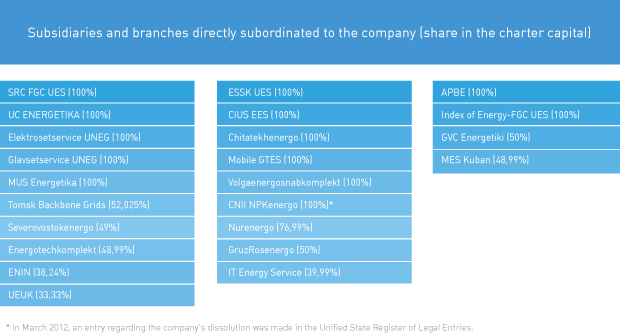
As of 31 December 2012, Federal Grid Company has 22 subsidiary and dependent companies operating in different industries, including support ing electric grid facilities. Two subsidiar ies (JSC Tomsk Backbone Grids and JSC Kuban Backbone Grids) are backbone grid companies.
Detailed information on the Company’s participation in subsidiary and depend ent companies (SDC) is available in the Appendix “Information on the Participa tion of JSC Federal Grid Company in the Operations of Subsidiary and Dependent Companies (SDCs), and in the Opera tions of Other Companies in 2012”.
The Company’s Geographical Scope
The Company operates in 75 Russian regions, encompassing 14.8 million square kilometers. The territory housing the Company’s facilities is divided into zones of responsibility for corporate branches, meaning backbone grid companies, known as the MES and PMES. Underpopulated territories with no major consumers, such as Chukotka, Kamchatka, the Magadan Region and Sakhalin, are not integrated into the UNEG due to the lack of economic conditions necessary to lay backbone energy transmission grids and establish major substations.
The Company’s Power Grid Assets
Federal Grid Company provides for the operation of more than 131 thousand kilometers of power transmission lines and 891 substations with a total transformer capacity exceeding 334.8 thousand MVA.
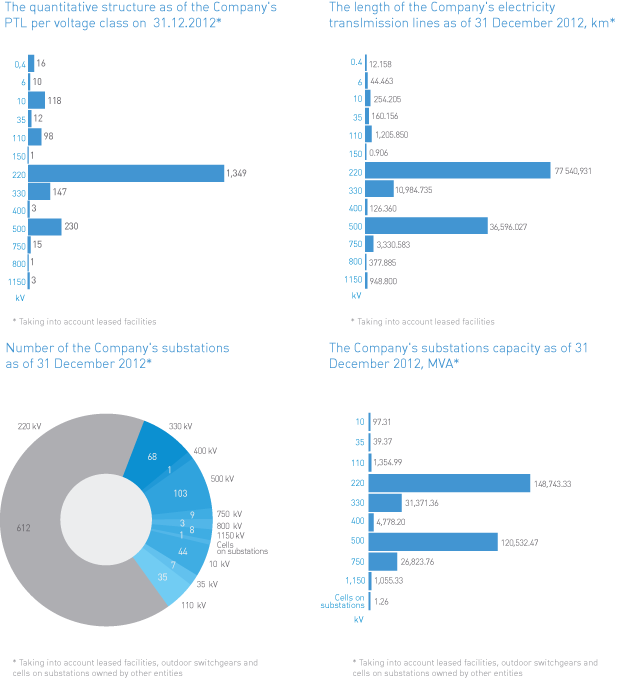
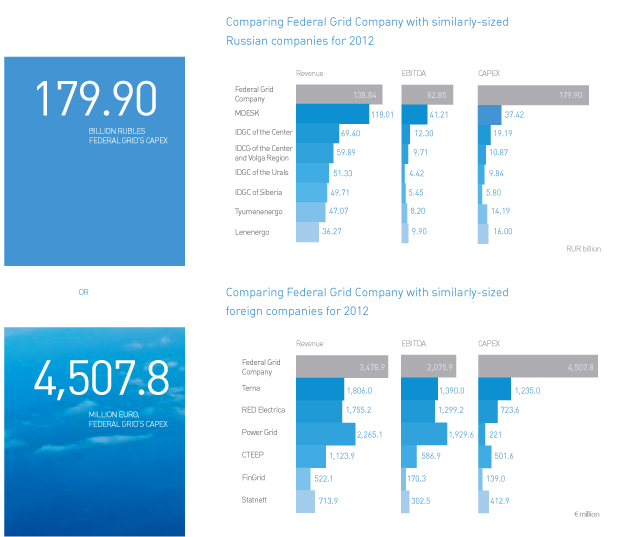
International Operations
Federal Grid Company functions as the carrier of electric energy over Russia’s customs border, as well as the technical contractor involved in performing all commercial contracts for importers and exporters on the Wholesale Electric Energy and Capacity Market. Pursuant to conditions of agreements concluded with JSC Inter RAO UES and JSC TGC-1, the Company accomplishes the transmission of electric power to the Russian borders via power grid facilities that are integrated into the UNEG and legally owned by the Company. Besides, the Company is engaged in acquiring and processing information on power transmission along the 139 inter-State power transmission lines. The information is based on data supplied by energy metering devices. The Company has concluded contracts for paid energy transit services using the power grids of Latvia, Lithuania, Estonia and the Republic of Belarus to supply electric power to Russian consumers in the Bryansk, Pskov, and Kaliningrad Regions. The Company also pays for energy transit through the territory of Kazakhstan pursuant to an inter-governmental agreement on measures providing for the parallel operation of the unified energy systems of Kazakhstan and Russia. According to the inter-governmental agreement concluded by and between the governments of Russia, the Republic of Kazakhstan, and the Republic of Belarus to provide access to the services of natural monopolies in the power industry, including price formation and tariff policy basics, in 2012, it became possible to transmit electric energy across the participating states, including transmission via the Russian UES grids. There are currently five agreements in force, stipulating the parallel operation of the Russian UES with energy systems of foreign states. The parties to these agreements include: the Federal Grid Company, and the economic entities of Georgia, Mongolia, Kazakhstan, the Baltic countries, and the Republic of Belarus. The Company also concluded an Inter-system Agreement with Finland. Besides, the Company concluded agreements for the technical provisions of parallel operation with Ukraine, the Republic of Belarus and Azerbaijan. The Company actively harmonizes power industry legal frameworks, forming and synchronizing markets for electric energy and capacity in accordance with inter-State initiatives (the CIS Power Systems and attached commissions, including the Commission for Operating and Engineering Coordination), the BRELL Energy Systems Committee, the Euro-Asian Economic Community Integration Committee, and task forces in the CIS Power Systems Executive Committee, Fingrid (Finland), KEGOC (Kazakhstan), Belenergo (Belarus) and the Russia – EU Energy Dialogue. The Company also cooperates with Asian countries (China and South Korea), developing cooperation with the Chinese State Power Grid Corporation. At the St. Petersburg Economic Forum in June 2012, the Company signed an agreement of intent with JSC Inter RAO UES, enabling the parties to initiate, promote, develop and implement new infrastructure projects between Russia and foreign states, and among foreign states and on their territories.

